
Arachnida is a class of joint-legged arthropods, in the subphylum Chelicerata. Arachnida includes, among others, spiders, scorpions, ticks, mites, pseudoscorpions, harvestmen, camel spiders, whip spiders and vinegaroons.

The Mesothelae are a suborder of spiders that includes a single extant family, Liphistiidae, and a number of extinct families. This suborder is thought to form the sister group to all other living spiders, and to retain ancestral characters, such as a segmented abdomen with spinnerets in the middle and two pairs of book lungs. Members of Liphistiidae are medium to large spiders with eight eyes grouped on a tubercle. They are found only in China, Japan, and southeast Asia. The oldest known Mesothelae spiders are known from the Carboniferous, over 300 million years ago.

Eurypterids, often informally called sea scorpions, are a group of extinct arthropods that form the order Eurypterida. The earliest known eurypterids date to the Darriwilian stage of the Ordovician period 467.3 million years ago. The group is likely to have appeared first either during the Early Ordovician or Late Cambrian period. With approximately 250 species, the Eurypterida is the most diverse Paleozoic chelicerate order. Following their appearance during the Ordovician, eurypterids became major components of marine faunas during the Silurian, from which the majority of eurypterid species have been described. The Silurian genus Eurypterus accounts for more than 90% of all known eurypterid specimens. Though the group continued to diversify during the subsequent Devonian period, the eurypterids were heavily affected by the Late Devonian extinction event. They declined in numbers and diversity until becoming extinct during the Permian–Triassic extinction event 251.9 million years ago.

Xiphosura is an order of arthropods related to arachnids. They are more commonly known as horseshoe crabs. They first appeared in the Hirnantian. Currently, there are only four living species. Xiphosura contains one suborder, Xiphosurida, and several stem-genera.
The Arthromygalidae are an extinct family of arachnids, possibly spiders. Fossils placed in the family were all found in the Carboniferous, 359 to 299 million years ago. They were considered by Alexander Petrunkevitch to be "mesotheles", i.e. placed in the spider suborder Mesothelae. Petrunkevitch used the family for Carboniferous fossils he regarded as mesotheles but which lacked eyes. Paul A. Selden has shown the fossil specimens only have "the general appearance of spiders", with segmented abdomens (opisthosomae), but no definite spinnerets.

Plesiosiro is an extinct arachnid genus known exclusively from nine specimens from the Upper Carboniferous of Coseley, Staffordshire, United Kingdom. The genus is monotypic, represented only by the species Plesiosiro madeleyi described by Reginald Innes Pocock in his important 1911 monograph on British Carboniferous arachnids. It is the only known member of the order Haptopoda.
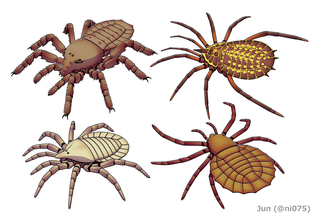
The order Trigonotarbida is a group of extinct arachnids whose fossil record extends from the late Silurian to the early Permian. These animals are known from several localities in Europe and North America, as well as a single record from Argentina. Trigonotarbids can be envisaged as spider-like arachnids, but without silk-producing spinnerets. They ranged in size from a few millimetres to a few centimetres in body length and had segmented abdomens (opisthosoma), with the dorsal exoskeleton (tergites) across the backs of the animals' abdomens, which were characteristically divided into three or five separate plates. Probably living as predators on other arthropods, some later trigonotarbid species were quite heavily armoured and protected themselves with spines and tubercles. About seventy species are currently known, with most fossils originating from the Carboniferous coal measures.

Tetrapulmonata is a non-ranked supra-ordinal clade of arachnids. It is composed of the extant orders Uropygi, Schizomida, Amblypygi and Araneae (spiders). It is the only supra-ordinal group of arachnids that is strongly supported in molecular phylogenetic studies. Two extinct orders are also placed in this clade, Haptopoda and Uraraneida. In 2016, a newly described fossil arachnid, Idmonarachne, was also included in the Tetrapulmonata; as of March 2016 it has not been assigned to an order.

The evolution of spiders has been ongoing for at least 380 million years. The group's origins lie within an arachnid sub-group defined by the presence of book lungs ; the arachnids as a whole evolved from aquatic chelicerate ancestors. More than 45,000 extant species have been described, organised taxonomically in 3,958 genera and 114 families. There may be more than 120,000 species. Fossil diversity rates make up a larger proportion than extant diversity would suggest with 1,593 arachnid species described out of 1,952 recognized chelicerates. Both extant and fossil species are described annually by researchers in the field. Major developments in spider evolution include the development of spinnerets and silk secretion.

Megarachne is a genus of eurypterid, an extinct group of aquatic arthropods. Fossils of Megarachne have been discovered in deposits of Late Carboniferous age, from the Gzhelian stage, in the Bajo de Véliz Formation of San Luis, Argentina. The fossils of the single and type species M. servinei have been recovered from deposits that had once been a freshwater environment. The generic name, composed of the Ancient Greek μέγας (megas) meaning "great" and Ancient Greek ἀράχνη (arachne) meaning "spider", translates to "great spider", because the fossil was misidentified as a large prehistoric spider.
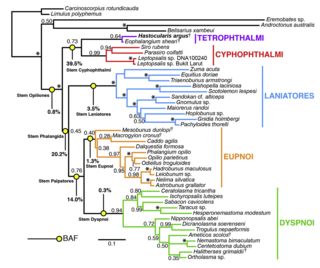
Harvestmen (Opiliones) are an order of arachnids often confused with spiders, though the two orders are not closely related. Research on harvestman phylogeny is in a state of flux. While some families are clearly monophyletic, that is share a common ancestor, others are not, and the relationships between families are often not well understood.

Campylocephalus is a genus of eurypterid, a group of extinct aquatic arthropods. Fossils of Campylocephalus have been discovered in deposits ranging from the Carboniferous period in the Czech Republic to the Permian period of Russia. The generic name is composed of the Greek words καμπύλος (kampýlos), meaning "curved", and κεφαλή (kephalē), meaning "head".

Adelophthalmus is a genus of eurypterid, an extinct group of aquatic arthropods. Fossils of Adelophthalmus have been discovered in deposits ranging in age from the Early Devonian to the Early Permian, which makes it the longest lived of all known eurypterid genera, with a total temporal range of over 120 million years. Adelopththalmus was the final genus of the Eurypterina suborder of eurypterids and consisted the only known genus of swimming eurypterids from the Middle Devonian until its extinction during the Permian, after which the few surviving eurypterids were all walking forms of the suborder Stylonurina.
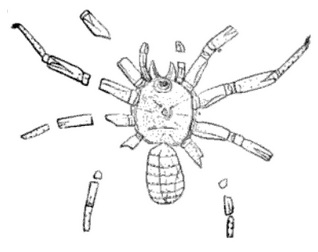
Arthrolycosa is an extinct genus of arachnids, possibly spiders, that lived about 300-250 million years ago.
Rosamygale is a genus of extinct Triassic spiders, with a single described species, Rosamygale grauvogeli. It is the oldest known member of the Mygalomorphae, one of the three main divisions of spiders, which includes well known forms such as tarantulas and Australian funnel-web spiders. It was described by Selden and Gall in 1992, from specimens found in the Middle Triassic aged Gres a Meules and Grès à Voltzia geological formations in France. It is also considered to be the oldest known member of the Avicularioidea, one of the two main divisions of Mygalomorphae.
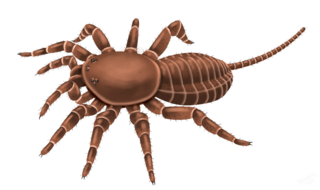
Uraraneida is an extinct order of Paleozoic arachnids related to modern spiders. Two genera of fossils have been definitively placed in this order: Attercopus from the Devonian of United States and Permarachne from the Permian of Russia. Like spiders, they are known to have produced silk, but lack the characteristic spinnerets of modern spiders, and retain elongate telsons.

Eocteniza is an extinct genus of arachnids containing the sole species Eocteniza silvicola, known from the Westphalian stage of the Carboniferous period in Coseley, England, about 313 million years ago to 304 million years ago. It was initially identified as a spider, but this is now doubted.

Idmonarachne is an extinct genus of arachnids, containing one species, Idmonarachne brasieri. It is related to uraraneids and spiders.
Palaeothele is an extinct genus of mesothele spiders, with only one known species Palaeothele montceauensis. Two fossils were found at Montceau-les-Mines, France, in ironstone concretion deposits of Late Carboniferous (Stephanian) age, about 304 to 299 million years ago.
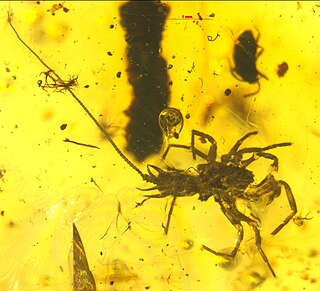
Chimerarachne is a genus of extinct arachnids, containing five species. Fossils of Chimerarachne were discovered in Burmese amber from Myanmar which dates to the mid-Cretaceous, about 100 million years ago. It is thought to be closely related to spiders, but outside any living spider clade. The earliest spider fossils are from the Carboniferous, requiring at least a 170 myr ghost lineage with no fossil record. The size of the animal is quite small, being only 2.5 millimetres (0.098 in) in body length, with the tail being about 3 millimetres (0.12 in) in length. These fossils resemble spiders in having two of their key defining features: spinnerets for spinning silk, and a modified male organ on the pedipalp for transferring sperm. At the same time they retain a whip-like tail, rather like that of a whip scorpion and uraraneids. Chimerarachne is not ancestral to spiders, being much younger than the oldest spiders which are known from the Carboniferous, but it appears to be a late survivor of an extinct group which was probably very close to the origins of spiders. It suggests that there used to be spider-like animals with tails which lived alongside true spiders for at least 200 million years.

















